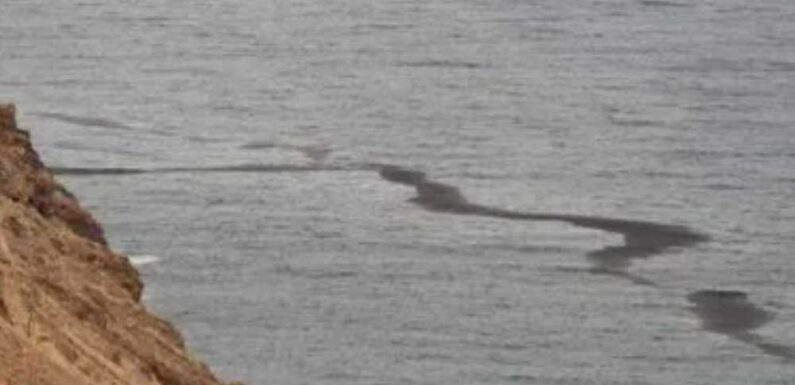
HOT ash is turning the sea black as out of control wildfires ravage Tenerife.
Officials have branded the blazes the "worst wildfires in 40 years", with thousands evacuated as flames sweep across the Spanish island.
As an uncontainable forest fire rages, part of the sea has been turned black as burning ash rains down.
Footage from the holiday resort of Las Caletillas on the north-east coast shows the water covered by a layer of ash.
A local who filmed the distressing images said: “Here you can appreciate the hell we’re experiencing.
“The water is literally black from ash in Caletillas.”
More world news
Heart-stopping moment Ukrainian Humvee crew survive being blown up by landmine
Dashcam vid shows private jet nosedive into busy highway killing 10
Another picture taken from the coastline at Candelaria showed a thick line of ash from the devastating forest fire snaking through the ocean.
The fires have ripped through more than 4,450 acres of land in just 24 hours – forcing 7,600 people to be evacuated from holiday homes and houses or forced to stay indoors.
It erupted in a mountain area between the towns of Candelaria and Arafo late on Tuesday, with six municipalities on the island now affected.
Regional President Fernando Clavijo said the island had been turned into a "virtual oven" as 250 firefighters work around the clock struggling to contain flames.
Most read in The Sun
Michael Parkinson dead at 88 after entertaining millions over 50-yr career
This Morning star engaged after surprise proposal from boyfriend
BBC reporter announces 'IVF miracle' baby with adorable pic to fans
Britney Spears' husband Sam 'files for divorce' just hours after split
He said: "This is probably the most complicated blaze we have had on the Canary Islands, if not ever, at least in the last 40 years."
Spanish authorities said their main goal is to contain the fire and prevent it from reaching more populated areas.
The island's main town, Santa Cruz, is just 20km away from the flames.
Clavijo said firefighters were working day and night but the fire remained out of control.
Families in the north who were told to leave their homes have spent the night either with relatives or in shelters or sports centres.
The fire has already destroyed one of the most iconic viewpoints to watch the sunset in Tenerife.
The viewpoint of Chipeque, in Santa Úrsula, is one of the favourite places for visitors and tourists to see Mount Teide.
Vicky Palma, a wildfire advisor to the Tenerife Council said the Canary Islands had never seen a blaze of the sort currently affecting Tenerife.
She said: “We’re seeing a type of fire we’ve never seen before in the Canary Islands.
“The fire has been generating convection in the 34 hours it has been burning.
“The column of flames has been three and six kilometres high, even at night-time.
“What’s in the sky between the Tenerife capital Santa Cruz and the city of La Laguna is not cloud, it’s the smoke from the fire.
“This generates its own meteorological conditions and affects nearby places.”
Hot ash from the main areas that are ablaze is also being transported by wind and causing smaller new fires.
The risk of wildfires breaking out was increased after the Canary Islands suffered a heatwave which left large areas bone dry.
Residents on the nearby island of La Palma, also part of the Canary Island off the coast of northern Africa, were told last month to evacuate due to a wildfire during a period of scorching temperatures.
Weather experts have declared 2023 an El Niño year – a natural phenomenon that occurs cyclically and causes fluctuations in the global climate.
Read More on The Sun
Strictly’s Giovanni ‘gives away’ celeb he’s dancing with after fans ‘spot clue’
Mum-of-22 Sue Radford reveals major setback whilst on 18th holiday in 20 months
The UN’s World Meteorological Organization said it will raise temperatures around the world, and the effect is likely to continue for the rest of the year.
And despite the heat this summer, Europe's record temperature of 48.8C – recorded in 2021 in Sicily – has not been reached and is currently not forecast to be broken.
Source: Read Full Article















